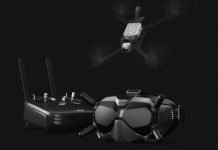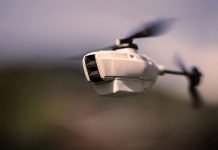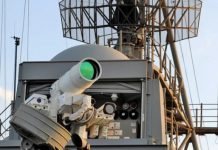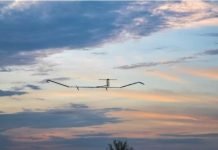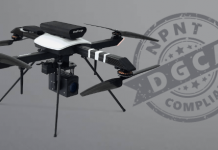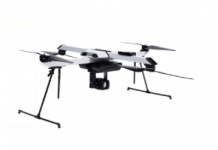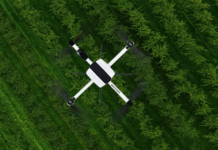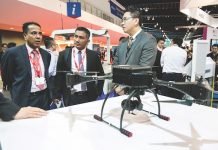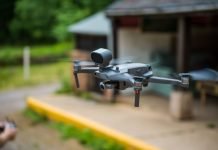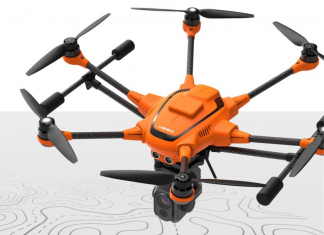DJI’s release of the Matrice 200 Series V2 caught many by surprise. With very little information on its release date or production status, it seemed to almost come out of nowhere.
That being said, we are committed to testing and reviewing all the newest DJI releases and drone related technology for you, and the new DJI Matrice 200 Series V2 is no exception. So, while we were in Henderson Nevada, training Law Enforcement and Fire department agencies on their new M210 RTK systems, we also spent a significant amount of time with a brand new DJI M210 V2.
In this review we’ll be focusing on the difference between the M200 Series V1 and M200 Series V2. We’ll also look at the V2’s functionality and new additions.
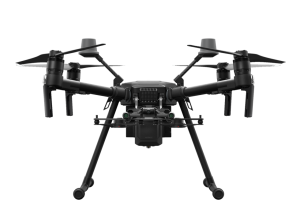
OCUSYNC 2.0
The new DJI M200 Series V2 has moved away from Lightbridge and replaced it with OcuSync 2.0. One of the biggest features this provides is the 256-bit encryption that gives you better data security. In addition the OcuSync 2 is going to give you a stronger signal quality across the board, that, in turns, allow for a longer range between the drone and the remote.
CENDENCE S | REMOTE CONTROLLER
It is important to note that the new M200 Series V2 is currently only compatible with DJI’s new remote, the Cendense S and are no longer compatible with older Cendence remotes, such as the DJI Inspire 2 remote.
Personally, we are not a fan of this limitation. In our experience, having trained multiple public safety agencies on drone integration, there are simply too many buttons and knobs that can accidentally be bumped. Therefore, it has always been our recommendation to clients to use the Inspire 2 remotes, which removed those issues and was more than capable of handling the clients specific applications for law enforcement and fire departments. This will no longer the an option moving forward and that’s unfortunate..
Don’t get us wrong, we feel the new Cendense S remote is a robust piece of equipment and is well constructed, and the having the new OcuSync 2 options are great. However, losing the option to choose a remote that better fits our clients needs, is, well, a step backward in our opinion.
DATA SECURITY
There’s a lot of clients out there that have been hesitant to use DJI because they’re afraid the collected drone data is not secure and could get into the wrong hands and/or information being sent back to China.
DJI has heard the concerns and has made some updates to address those concerns. The first thing they changes within the OcuSync 2is adding a 256-bit encryption. This is a big Improvement for that will ease many users that are worried about their data being stolen out of the sky.
The second new feature DJI introduced, is ‘Local Data Mode‘ and is also available for older drones, This feature allows you to prevent the drone from connecting to the internet and stop it from transmitting data.
For agencies such as law enforcement, that have sensitive data, the 256-bit encryption is a great improvement for data security while it’s in the air and ‘Local Data Mode‘ keeps it from transmitting online and going back to China.
FRAME
The DIJ M200 ad M210 (RTK) V2 frame is very similar to the original M200 and M210. The overall construction of these units are absolutely outstanding! As with the original M200 V1, you don’t see anything thin, flimsy or any cheap-corners being cut. It’s almost an identical frame.
It fits in the original GPC (Go Professional Case) case that we use for the older versions, however, it’s slightly a little tighter fit.
The reason for the tighter fit is the redesign of the front gimbal. The dual gimbal mount has been redesigned to be a little bit more aerodynamic. It slightly angles off to the sides causing it to fit in the case slightly tighter.
Having said that, GPC has told us that the current case for the M200 Series V1 will also be the same case used for M200 Series V2.
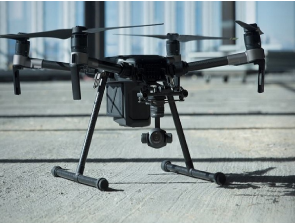
FLIGHT PERFORMANCE
We have flown the M210 V2 on numerous occasions at different locations, testing it in a variety of different applications. We can tell you, it definitely flies the same as the original M210 aircraft. There’s was absolutely no difference in how the DJI M210 V2 handled itself in take-off, maneuverability, standard flights, wind condition flights, landing, or how the operator would control the unit. Like the original, it flies very well.
To get more information on flight and test conditions, please view our DJI MATRICE 200 SERIES V1 | Comprehensive Test and Review.
ANTI-COLLISION BEACONS
In the past, for clients that need to operate their drones at night, we provided options that would involve customizing the unit to mount a light on top. It did a good job, but, it had no options to mount on the bottom.
The M200 Series V2 now come with 2 Anti-Collision Beacons built into the units, one mounted on the top and one mounted the bottom of the aircraft. This might be our favorite upgrade on the new series.
When we were flying this in the middle of the day, we were blown away by how bright it was and by how well it worked. It is, without doubt, a superior upgrade compared to previous units. It’s not even necessarily just for night flights, as you can use this during the day to assist in maintaining your line-of-sight with the drone while in flight.
We should also note that DJI made it extremely easy to activate or deactivate the beacons with a simple on-off button in the top corner of the app. You simply turn the light on and turn the light off. There is no buried menu searching to operate the beacons.
Lastly, when had to customize the older drones to house a beacon, it also meant we had to use the extra power port in the back of the unit to power it. Now, that power port can be left available for something else.
Overall the Anti-collision Beacons are great added feature that we really liked on the DJI M200 Series V2 compared to the original DJI M200 Series, which had none.
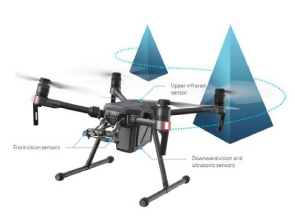
BATTERY COMPATIBILITY
The new Matrice 200 Series V2 can only support the TB55 battery. Whereas, in comparison to the original Matrice 200 Series V1units, you had the option to use TB55 or TB50 batteries.
Once DJI released the specs publicly, this change to the battery requirements become a very polarizing topic among drone owners and operators alike.
So, is this a good or bad change?
When you’re flying a M200 or M210 RTK aircraft and operating 2 sensors, you want that extra battery time. If you’re really loading it down with TB50 batteries it’s going to be anywhere from 15 to 18 minutes and no one likes that limitation. The TB55 extends that time, giving you a significant more amount of productive flight time. More flight time is always great, having said that, it comes at a price.
The TB55 batteries are over double the amount in cost compared to the TB50 batteries. That can get extremely pricey, and if you’re looking to buy an additional four or five pairs of batteries, the price alone might just be a deal-breaker, as to whether or not, you can afford it.
Another major draw back is the inability to easily travel with the TB55 batteries. Currently, TSA regulations prohibit traveling with more than x2 TB55 batteries as carry-on luggage. Whereas, the TB50, you are allowed to travel with an endless amount (*they are rated right under the 100 Watt/hr level). So, unless you’re traveling with a big crew, you’re most likely going to have to package them up and send them out in advance.
The battery compatibility change that DJI made will most likely prove to be an issue for many people starting up their drone business, where as, some specific agencies, will probably not be as impacted by this change. Either way, like it or hate, there’s currently no way around these issues and it’s just something we’ are going to have to get used to for now.


